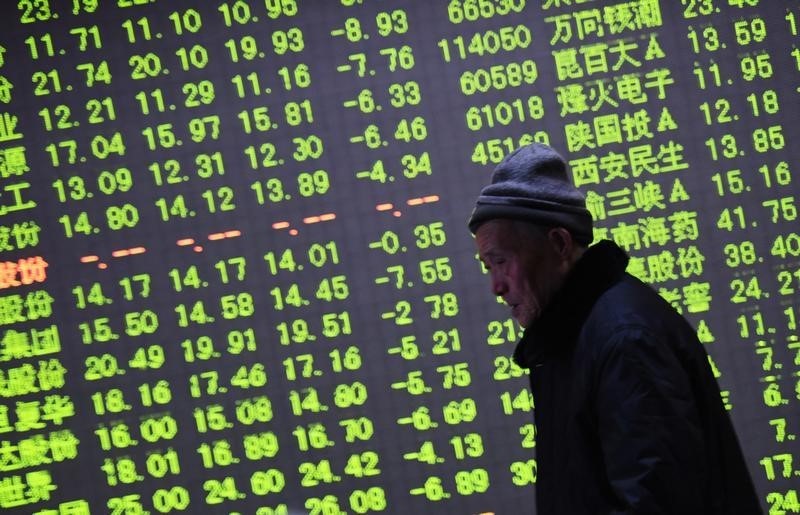By Nathaniel Taplin and Samuel Shen
SHANGHAI (Reuters) - China's fragile shares ended higher on Friday, in a relatively muted response to hints of more policy stimulus in Europe and Japan that prompted a robust rally in battered oil prices and equities elsewhere.
While Japan's Nikkei jumped nearly 6 percent and Brent crude was up more than 5 percent, the benchmark Shanghai Composite Index <.SSEC> managed a rise of just 1.25 percent, following sharp losses on Thursday.
The CSI300 index (CSI300) of the largest listed companies in Shanghai and Shenzhen closed up 1 percent.
The indexes veered between positive and negative territory during the day, with little volume behind the trade. The Shanghai Composite did at least end the week marginally higher than it began, for the first time in 2016, but not the CSI300.
Investors appear increasingly reluctant to risk their money on China's fickle markets, which have slumped about 17 percent so far this year, and morning gains have often turned to losses by close of day as traders quickly take profits.
Highlighting the lack of faith in the markets, trading volumes in January have been about a third of typical levels last year, which only exaggerates price movements.
On Thursday, Vice President Li Yuanchao sought to reassure investors that Beijing would use regulations to prevent volatility in a market that was "not yet mature".
"An excessively fluctuating market is a market of speculation where only the few will gain the most benefit when most people suffer," Li, who is attending the World Economic Forum in Davos, said in an interview with Bloomberg.
Measured by actions rather than words, regulators' attempts to curb volatility, notably a new circuit breaker mechanism that was ditched after three days of violent falls, have conspicuously failed.
The stock markets and China's yuan currency have come under pressure as a raft of economic indicators have confirmed the country's declining growth, putting the world's second-largest economy at the top of global investors' worry list along with plunging crude oil prices.
There were some rare nuggets of good news on Friday, with data showing a pick-up in lending to China's property market, and that urban unemployment was unchanged at 4.05 percent, comfortably below the government's target. But most economists believe China's real jobless rate is higher.
Concerns about another near-term yuan devaluation are slowly fading as the People's Bank of China (PBOC) has steered a steady course for the currency daily midpoint fix
The spot yuan
European and U.S. markets took heart after European Central Bank President Mario Draghi dropped a heavy hint that more stimulus could come as early as March.
His comments sliced 1 percent from the euro as markets quickly priced in a rate cut for March, three months ahead of previous forecasts.
GENEROUS LIQUIDITY
Speculation is also rife that the Bank of Japan might ease policy further, possibly as early as next week.
The central bank is "taking a serious look" at expanding its asset-buying campaign as sliding oil prices make it ever harder to reach its 2 percent inflation goal, the Nikkei newspaper reported on Friday.
All of which was grist to the mill for those expecting more action from the People's Bank of China (PBOC).
The central bank has already been generous with liquidity, pumping a net 315 billion yuan ($48 billion) into the banking system ahead of the Lunar New Year holiday in early February.
It was the biggest weekly injection since January 2014 and analysts suspected it was larger than that warranted to avoid any hint of a cash crunch during the long holiday.
According to sources, Zhang Xiaohui, an assistant governor of the central bank, said it would not rush to cut the amount of cash banks must hold in reserves, as doing so could send a strong signal on policy easing.
Yi Gang, a vice governor of the central bank, also said it would keep the yuan basically stable against a basket of currencies.
There was more reassurance from officialdom in Davos.
Fang Xinghai, the vice chair of the Chinese Securities Regulatory Commission, sought to counter concerns China was seeking to devalue the yuan to gain a competitive advantage for its exports.
"A depreciation is not in the interests of China's rebalancing; a too deep currency fall would not be good for consumption," Xinghai said.
Speculators have taken to using the yuan's cheaper offshore forwards market to wager China will finally devalue the currency around March or April.
Economists at ING, however, said they were expecting policy measures to keep the yuan's fall in check, forecasting a mid-year rate of 6.72 to the dollar and a pick-up to 6.60 by year-end.
"Earlier this month Li Daokui, an economist at Tsinghua University and former member of the PBOC MPC, said foreign reserves needed to be kept above $3 trillion. We expect tighter exchange controls and macroprudential measures to enable the authorities to do that and curb depreciation pressure while cutting interest rates," ING said in a research note.
China has jolted global markets twice in the last six months by allowing sudden, sharp slides in the yuan and then intervening aggressively to stabilize it, sparking confusion over its policy.

Central bank action to temper the depreciation has brought China's foreign reserves down to about $3.3 trillion from nearly $4 trillion in the middle of 2014.